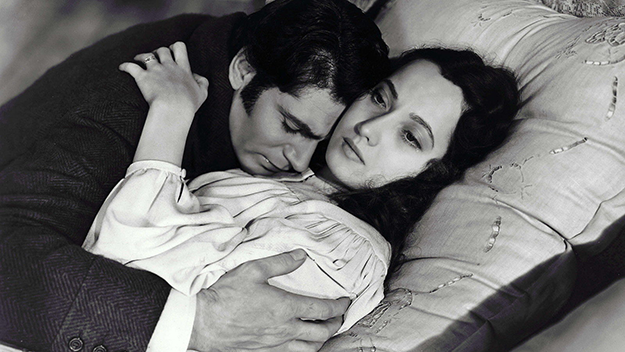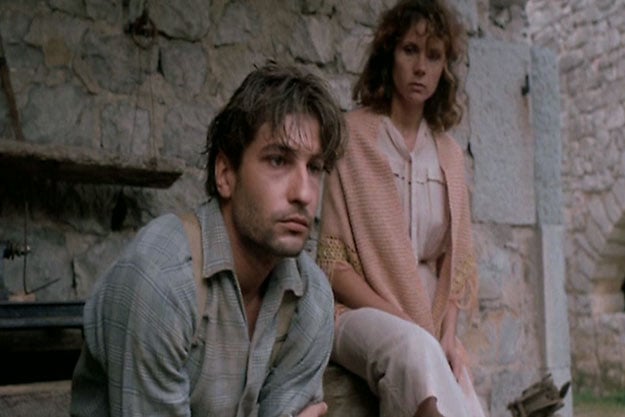Wuthering Heights on Screen

Wuthering Heights (William Wyler, 1939)
“Wuthering Heights must appear a rude and strange production,” Charlotte Brontë wrote, in apology for the untamed and harsh character of her sister Emily’s novel, published in 1847. “It is moorish, and wild, and knotty as a root of heath . . . In its storm-heated and electrical atmosphere, we seem at times to breathe lightning.” The description of Wuthering Heights as a crude outpouring of unconscious passions might fit the cultural legacy of the novel more than the book Emily wrote. Far from being simply elemental or atmospheric, Wuthering Heights has an intricate internal timeline, concealed by a compounding of unreliable narrators, impenetrable regional dialects, and arcane issues of inheritance law. Few novels are as precisely structured. And yet the story of Heathcliff’s pitiless love for Catherine Earnshaw, indistinguishable from the revenge he takes upon her for marrying Edgar Linton, has spawned a rough and dreadful cinematic brood of films from many different cultures. Filmmakers have been especially drawn to the horror elements in the novel: hanging of dogs, and grave-desecration in the source material, among other scattered threats of eye-gouging and blood-drinking.
The first Hollywood adaptation, William Wyler’s version of 1939, renders the horror elements as romantic atmosphere: ghosts, cobwebs, a vague evil clinging to Heathcliff’s “gypsy” origins. Laurence Olivier as Heathcliff even recalls Bela Lugosi’s Dracula, whose haughty mien is broken by sudden transports of reverie and violence. Although this adaptation, like all the others, is “unfaithful” to the text in various ways (appropriate to a novel where faithfulness means unsocialized violence), the inclusion of the frame story, where we encounter Heathcliff decades after the main events, is key to understanding his character. Having outlived his enemies, his demonic vitality is left only to consume itself. His vital self is the past. Like Don Quixote, he sees himself as belonging more to another plane of reality than to the nonentities surrounding him in the present.
Dropping the “heights” of Brontë’s title for the “abysses” of tormented love, Luis Buñuel’s 1954 version, Abismos de passion, could easily be mistaken for a forerunner of the overheated melodrama of Mexican telenovelas. Adapting only about 80 pages of the novel, Buñuel restricts himself to the two overlapping love-hate triangles. These are presented with a minimum of subtlety, as in “I want to marry her only to hurt you!” or “Your husband cheats on you with a dead woman!” But beneath the soap opera, one can still recognize Buñuel the surrealist and the communist. The former shows farm workers slashing a squealing pig’s throat, against the backdrop of Heathcliff (whip in hand) courting Isabella; the latter lampoons the hypocrisy and impotence of the sadistic crybaby Linton. Buñuel also shifts focus from the revenge taken by the upstart Heathcliff upon on the gentry who spurned him, towards the self-defeating antagonism between Earnshaw and Heathcliff. The tragedy, as emphasized in Buñuel’s tweaking of the ending, is a political one: the non-recognition of Linton as the true class enemy. For once, Heathcliff is not the villain.

Hurlevent
Jacques Rivette’s 1985 Hurlevent (simply “Wuthering”) also sees Heathcliff as a regrettable casualty, not as the main event. It the only version to use the same cast for both time periods in the film, when Heathcliff and Cathy (Lucas Belvaux and Fabienne Babe) are wild children roaming the moors, and afterwards when he has made his fortune and she is a married woman. But this casting decision amounts to an entire reinterpretation of the story, since the earlier period of confused asexual roughhousing now looks like commonplace teenage necking, and the later period like “dress-up.” In this light, Heathcliff’s motivations seem less like a “quenchless and ceaseless ravage” than a sullen adolescent grudge. But the same perspective turns out to capture perfectly Catherine’s motivations. As in Rivette’s more widely known films Céline and Julie Go Boating, Le Pont du Nord, and Joan the Maid, the concern is with a young woman whose richly imaginative yearning for autonomy verges on dissociation. What is attractively whimsical threatens to become simply unhinged. As ever, Rivette is interested in the unendurable demands of reality and connection, which appear to his heroine only as coercion and confinement.
Relocating the source material in medieval Japan, Yoshishige Yoshida’s 1988 Wuthering Heights follows Akira Kurosawa’s practice, in his versions of Macbeth and King Lear. Yoshida also borrows the mist-draped volcanic landscape of Throne of Blood for his setting, and its uncanny loom-spinning witch for his own frame narrative. But the similarities stop there. Yoshida’s story eschews Kurosawa’s humanism, steeping the familiar events in prurient degradations: Heathcliff now rapes his own daughter, before having his arm severed in a duel. (But it is only a “flesh wound,” in Monty Python’s sense.) Although Brontë’s Heathcliff was “a magnate of the infernal world,” his revenge was scrupulously legal and long-meditated; Yusaku Matsuda plays him here as a blasphemous wild man with no inner life. He is a “demon” simply to be slain, or expelled from this world, whereas Brontë’s ending followed Milton’s conception of Satan as one who, for all his “dark designs,” brought forth only “goodness, grace and mercy.”
English filmmaker Andrea Arnold’s 2011 Wuthering Heights, by contrast, sees Heathcliff not as a self-contained enigma, but as a problem for the identities of those he is dependent upon, and within the environment he is unceremoniously abandoned to. But by casting two black actors to play Heathcliff, Arnold perhaps presses down on the scale of interpretation, naming the cause of his disruptiveness too soon. In other versions, and in the novel, Heathcliff’s revenge is to lay waste to a world of which he is then condemned to be its only survivor. In place of the “flinty gratification” Brontë’s Heathcliff feels at his Pyrrhic victory, Arnold leaves Heathcliff exposed to bouts of abjection. Any film version faces the risk of being too explicit in laying over a set of motivations and origins for his violence, or else of judging him too quickly as beyond excuse or account. But what he wants is not nameable only because it is not possible. Each film then puts forward a different solution to the problem: that what is real for Heathcliff and Cathy eludes any representation other than in its destructive consequences and frustrations. For Wyler and Arnold, it is the symbolic or lyrical intensity of the landscape; for Buñuel, more cynically, it is the superstitious fetishism of folk Catholicism; for Rivette, it is the otherworldly strains of Bulgarian-language choir music; most troublingly, for Yoshida, it is the unearthed, maggot-eaten body of Catherine itself. We are alienated and kept out of these visions; they are not.
Heathcliff, It’s Me: Adapting Wuthering Heights includes adaptations by William Wyler, Luis Buñuel, Jacques Rivette, Yoshishige Yoshida, and Andrea Arnold, and runs from February 24–27 at the Film Society of Lincoln Center.
Ben Parker is assistant professor of English at Brown University, where he teaches on Victorian novels and poetry.







